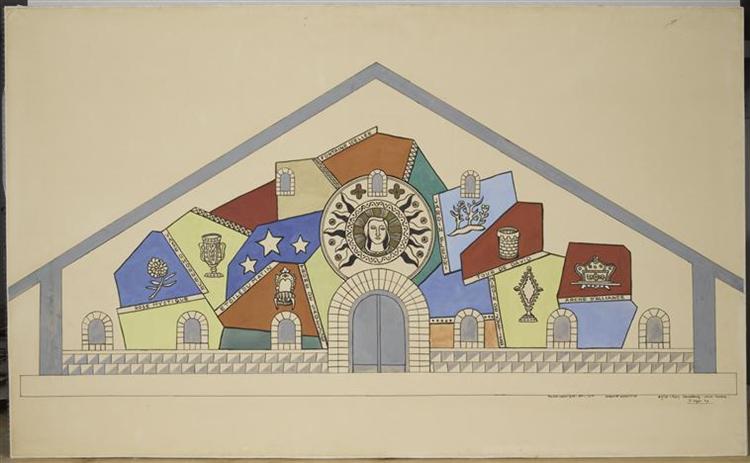Description
The work "Mobile for the mosaic of the Church of Our Lady of all graces" (1947) by Fernand Léger is erected as a palpable testimony of the aesthetic and conceptual evolution of one of the great masters of modern art. While Léger's work is traditionally associated with Cubism and exploration of geometric shapes, this specific piece reflects a singular fusion between abstractionism and a tangible approach to spirituality through religious art. The work, conceived as a model for a mosaic in the aforementioned Church, is not only covered in the religious tradition, but also redefines it through a contemporary and nuanced perspective.
From the first glance, the composition is presented as a vibrantly organized display of shapes and colors, characteristic of Léger's visual language. The color palette is intense and varied, with predominance of blue, yellow and red, which evoke the typical luminosity of the ecclesiastical stained glass, at the same time that they introduce an element of modernity that blurs the borders between the sacred and the secular. The geometric shapes that are intertwined on the canvas tell us about the industrial world and the machinery of modern life, a constant in Léger's work that becomes especially relevant in the postwar context, where the search for meaning and reconnection With the spiritual they became essential.
Although the mosaic is a conceptualized work for the Church, Léger is not limited to the traditional representation of religious figures. The presence of human figures, although stylized and abstract, suggests a narrative of unity and community, key elements in Christian practice. These figures, often an amalgam of simplified features, recalls the work of previous artists who sought to humanize the divine, but through a lens marked by modernity. The abstraction that Léger uses, as opposed to a more orthodox figurative narrative, allows each spectator to establish a personal and subjective connection with the work, transforming a sacred space into a place of individual reflection.
The creative process behind the mosaic is equally fascinating. Léger, an artist who embraced the idea of the work as a vehicle of communion and social dialogue, used art not only as a means of personal expression, but also as a mode of cultural engagement. This work, therefore, is not merely an aesthetic representation; It is a call to the reinvention of the sacred space, a space that, through its aesthetic reinterpretation, seeks to attract new generations of faithful and spectators.
Léger's work can be understood as part of a broader dialogue in the art of the twentieth century, where the inheritance of Cubism is in tension with contemporary issues related to mechanization, war and hope. When observing "mock mock", it becomes clear that Léger, in her search for a visual language that was both universal and accessible, offers a vision that is both innovative and respectful of its historical and cultural context.
In conclusion, "model for the mosaic of the Church of Our Lady of all thanks" is not only a work of art, but a manifesto about the ability of the art to transcend its ornamental functions and become a vehicle of social and spiritual transformation vehicle . Léger's mastery lies in his ability to intertwine tradition with modernity in such a way that the viewer is invited to a continuous dialogue with art, faith and existence itself, thus raising a present where the sacred and the everyday coexist In harmony.
KUADROS ©, a famous paint on your wall.
Reproductions of paintings handmade oil, with the quality of professional artists and the distinctive seal of KUADROS ©.
Art reproduction service with satisfaction guarantee. If you are not completely satisfied with the replica of your painting, we refund your money 100%.

